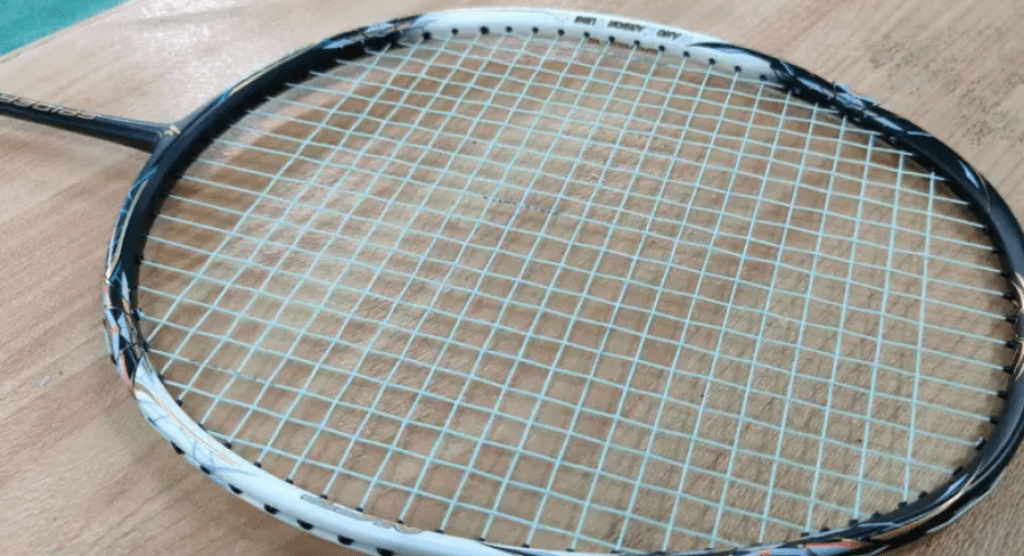As early as 2020, Kawasaki’s Spider-Man 9900II left me with a very poor impression as a flagship offensive racket at the time. It was heavy and stiff, far beyond my ability to handle, and I never had a pleasant moment using it.
This year, a familiar friend mentioned that Spider-Man is preparing a new model, which also uses top-grade materials. I saw the leaked photos, and the design seemed acceptable. However, after the initial testing, my friend couldn’t tolerate it—too stiff, and it needs to go back to the drawing board.
I previously had strong apprehensions, but recently I’ve started to adopt a more balanced mindset.

Specifications: 4UG5, with a base, total weight in play 95.0g, balance point 300mm, shaft length 215mm, high stiffness, Diamond Wind-breaking frame, 76-hole string bed, 8-4 o’clock string grooves, warranty for 30 lbs, string tension 25-27 lbs.
It looks good; indeed, it’s a classic Kawasaki. Compared to the previous two flagship Spider-Man models that used a black base with enhanced fluorescent orange/green accents, the 8100Pro is clearly more refined. The frame and shaft base use white base paint, while the frame head and T-joint are black, creating a layered effect. The design details of the paintwork are very rich and delicate, with stickers and colorful lines at the 4, 8, 10, and 2 o’clock positions, making the visual effect abundant and showcasing traditional advantages.
From the parameters of the cone cap, it seems this version of Spider-Man is much gentler, with neither the stiffness nor the head heaviness being the highest grade. After handling it, the 8100Pro indeed has a strong head-heavy feel, but in the 4U specification, it is not exaggerated in terms of swing weight, making it a typical offensive racket feel.
Previously, a fellow player posted about an imbalance in the weight distribution on the sides of the frame, but I haven’t noticed such issues with my equipment yet. However, if this is true, Kawasaki’s reputation for product quality control could be questioned.

To be honest, the 8100Pro is relatively easy to handle. Once accustomed to the current swing weight, the racket provides excellent power leverage, and the sweet spot is easy to control. The ball quality is quite good; it can consistently send the shuttlecock with a high arc between the two baselines in a leisurely manner, without needing to exert much control over power, thanks to its strong leverage. The shaft is still on the stiffer side, but when adding power or performing quick movements, you can feel the shaft’s deformation, and its effect on the shuttle speed is visibly noticeable. During rallies, it is easier to hit high, powerful shots that pressure the opponent, occasionally going over their head.
Additionally, despite its stiffness, it is not harsh on the hands.
Speaking of the Diamond Wind-breaking frame, I think of the Lightning Series and Super Nano Series. They claim to balance stability and swing speed, but they still tend to resemble box-shaped frames more. With this frame type, the high head-heavy feel naturally does not provide high swing speed for the 8100Pro. However, in terms of stability, the racket performs well in anti-torsion, as it uses 46T+80T grade carbon fiber materials in the frame, ensuring rigidity. The only concern is whether Kawasaki’s familiar formula for the Diamond Wind-breaking frame might lead to cracking.

Previously, the performance of such rackets in defense was a nightmare for me, but Spider-Man’s defensive feel is quite outstanding. Whether defending against smashes or making quick flicks near the net, it is stable and responsive. Although I would not actively push the pace to a defensive rhythm, I can at least escape when the opponent attacks. The same technique can also be used in doubles defense, where it can effectively counter and disrupt the opponent’s continuity. In slower, continuous counter-attacks, I am satisfied with the feel of the Spider-Man 8100Pro.
For players with good power who do not like to follow up, Spider-Man’s down-pressure capability is a strong weapon for an aggressive style. Indeed, the combination of head-heavy and a highly elastic shaft endows the 8100Pro with a deep reserve of offensive capability. With strong materials supporting it, as long as footwork and power execution are on point, it is not difficult to achieve the whip-like sensation of the racket, accompanied by a somewhat dull but loud echo. The shuttlecock’s impact is like an APFSDS projectile, powerfully shaking or even directly penetrating the opponent’s defense.
However, it must be noted that while the upper limit is high, the physical exertion required is also significantly noticeable. It is quite common to switch to a defensive state after a few smashes due to fatigue.

In a passive state or fluctuating ability, the Spider-Man’s performance struggles have not shown significant improvement. According to current feedback on this new product, there is a polarization trend, with even the same player experiencing different feelings at different times. This indicates that the Spider-Man 8100Pro might have a dividing line, significantly varying based on the user’s condition and preferences.
This is a product with very clear positioning and target audience. From using the 9900II three years ago to today’s 8100Pro, I personally feel that the difficulty of use has decreased. However, whether this is due to the increased driving feel of the racket or my own improved skills is hard to say.
I only recommend players who are fond of this type to give it a try. After all, this is currently Kawasaki’s top-level racket in terms of materials and craftsmanship, continuing the Spider-Man series style, and achieving a very high standard.

Leave a Reply